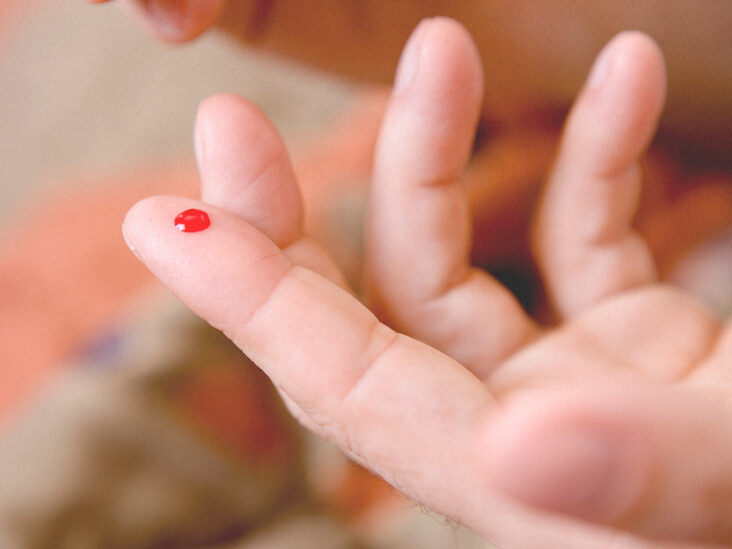4,752 total views, 2 views today
Even though it may seem logical to us that a child should inherit the blood type/group of his or her parents, this does not mean it happens every time. For example, parents with blood type O an AB can either have children with blood group B or blood group A, these two blood types as we can see obviously differs from the parent blood types. But in a situation where the two parents have blood type O, their children will always be of blood group O.
From the examples above, you can see that sometimes a child blood type matches with his/her parents own and sometimes it doesn’t. There are some rules in genetics that govern these outcomes, although like most rules there are always exceptions attached to them, we will discuss the rules extensively in this article. ( Read an important article on the importance of knowing your genotype and blood group before marriage here)
DNA carries the instructions for making any living thing, so as a human being, your DNA holds the instruction for making you. We as humans are made up of about 2000 genes, a gene has a specific instruction for a small part of us, the deferent versions of these genes makes us different. For example, humans have the blood group gene ABO. The source of our different blood types is the different version A, B, and O that this gene comes as. (Read an interesting article on the effect of genotype AA, AS, SS on Malaria here)
As humans we have two copies of most of our gene, one from each parent, who also has two copies of their own gene too from their own parents, since we have dual copies of blood type gene and each gene has three possible versions, so it means there are six combinations that a child can pick from.

Since genes are instruction for protein, and the O version of the ABO gene does not make any version of protein then the 6 combination ends up resulting in just 4 as shown below. ( Read an interesting article on Sickle cell anaemia (SS) and how to manage its crises here)
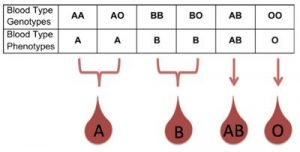
So it means the AO is just A blood type since it only makes A protein versions
Also, BO is blood type B because it only makes B protein versions
How to know or figure out a child’s blood group/type
The easiest way to know what blood type a child will likely have is by inserting the parent’s blood type in a Punnet square
First, insert the ABO gene version of the father like this:

In this example, the father is AA, to keep track, the blood type will be shaded blue
If the mother is also AA, the Punnet square will look like this below
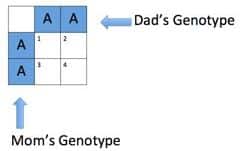
Since both parents are AA it really not complicated, remember that a child can only get one copy of the gene from both parents, so working the punnet square by combing each box we get this
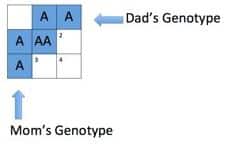
Doing the same thing for boxes 2, 3, and 4 we get

Now you can see that a child will definitely have blood type AA if both parents are AA. (Read an interesting article on how the immune system of the body works here)
Now let’s check an example where both parents are AO
Inserting the parent’s blood type and working the boxes out we have:
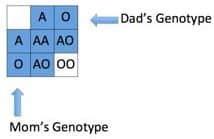
We can see that a child from to AO parents can either be AA or AO or O blood type
Let’s try one more Example
Let us use a scenario where the father is AB and the mother is OO blood type
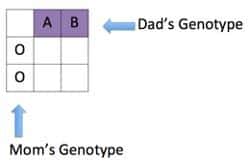
Working the Punnet square out, we then have:
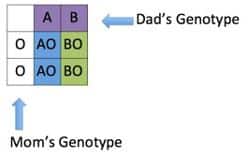
Now you can see that this is a scenario where the child’s blood group or blood type is unlike any of the parents own, the child possible blood type outcomes are AO and BO which is different from the parent’s blood type.
So using the Punnet square you can work out any possible Blood types from the father and the mother and use it to find possible blood types of their children or offsprings. (Read an interesting article on preventing mosquito bites here)
If you find this Article interesting, please “Like” and “Share” it on Facebook and Twitter by clicking the buttons below. Also, don’t forget to drop a comment. Thanks
